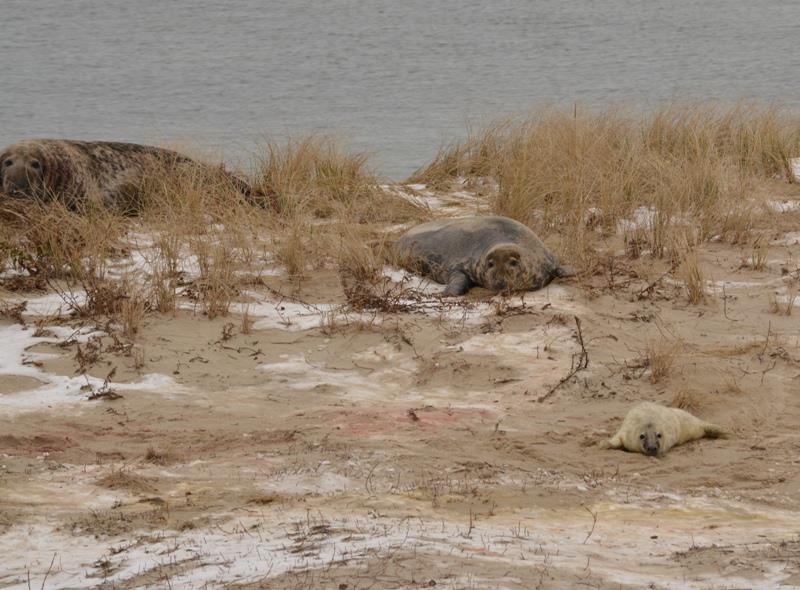
Gray seal pup surveys underway on Muskeget, Monomoy Islands
by NOAA Fisheries 21 Jan 2018 22:55 UTC

A gray seal pup at rest (bottom right) not far from an adult female (center) and adult male (far left). Image taken under MMPA research permit #17670-04 © NOAA Fisheries / Michael Abbott, NEFSC
Northeast Fisheries Science Center (NEFSC) researchers and colleagues will visit Muskeget and Monomoy islands off the southeastern Massachusetts coast this month to study gray seal pups born on the islands in December and January.
Gray seal pupping season generally runs from mid-December to early February, with peak time in mid-January. Fixed wing drone and hexacopter surveys will be conducted to estimate gray seal abundance and distribution and to estimate age of the pups on Muskeget. Researchers will capture pups, attach a flipper tag, and collect biological samples at both locations. Similar work has been underway by NEFSC researchers and colleagues for the past six years.
Recent frigid weather and ice conditions have prevented a trip by sea from Woods Hole, but the US Coast Guard joined forces with the NEFSC and transported several NOAA researchers, including two drone pilots from NOAA's National Ocean Service, to the island on January 11 via a H65 helicopter. The H65, which landed in the interior of the island away from seals, posed very little visible disturbance to the seal colony. After the helicopter departed, the team spent about 3 hours on the ground before being picked up. Although windy conditions prevented flights with their fixed wing drone, researchers were able to walk the island collecting data on seal behaviors, pup molt stages, and any natural mortalities.
On December 18, nine NEFSC staff members visited Muskeget for the first time this pupping season. Drone pilots collected information on the distribution of animals on the island and approximate ages of the pups. Researchers saw lots of newly born pups and witnessed a live birth. Acoustic receivers were deployed around the island by small boat to pick up transmissions from pups to be tagged on the return visit in January.
Muskeget is a small low sandy island six miles northwest of Nantucket. It is privately owned and is the largest gray seal breeding and pupping colony in the U.S. Monomoy National Wildlife Refuge south of Chatham is also a primary gray seal haul-out on the U.S. East Coast, although the number of pups born there is much lower than on Muskeget. Last year, researchers were able to capture, tag, sample and release 127 seals. A new pilot project this year plans to put acoustic tags on Muskeget seal pups to study movement patterns after they leave the colony.
The team hopes to tag 50 seal pups on Muskeget, 18 of which will have acoustic tags, and 100 pups on Monomoy. If the acoustic pilot project is successful on Muskeget, the team hopes to also put acoustic tags on pups from Monomoy in the future.